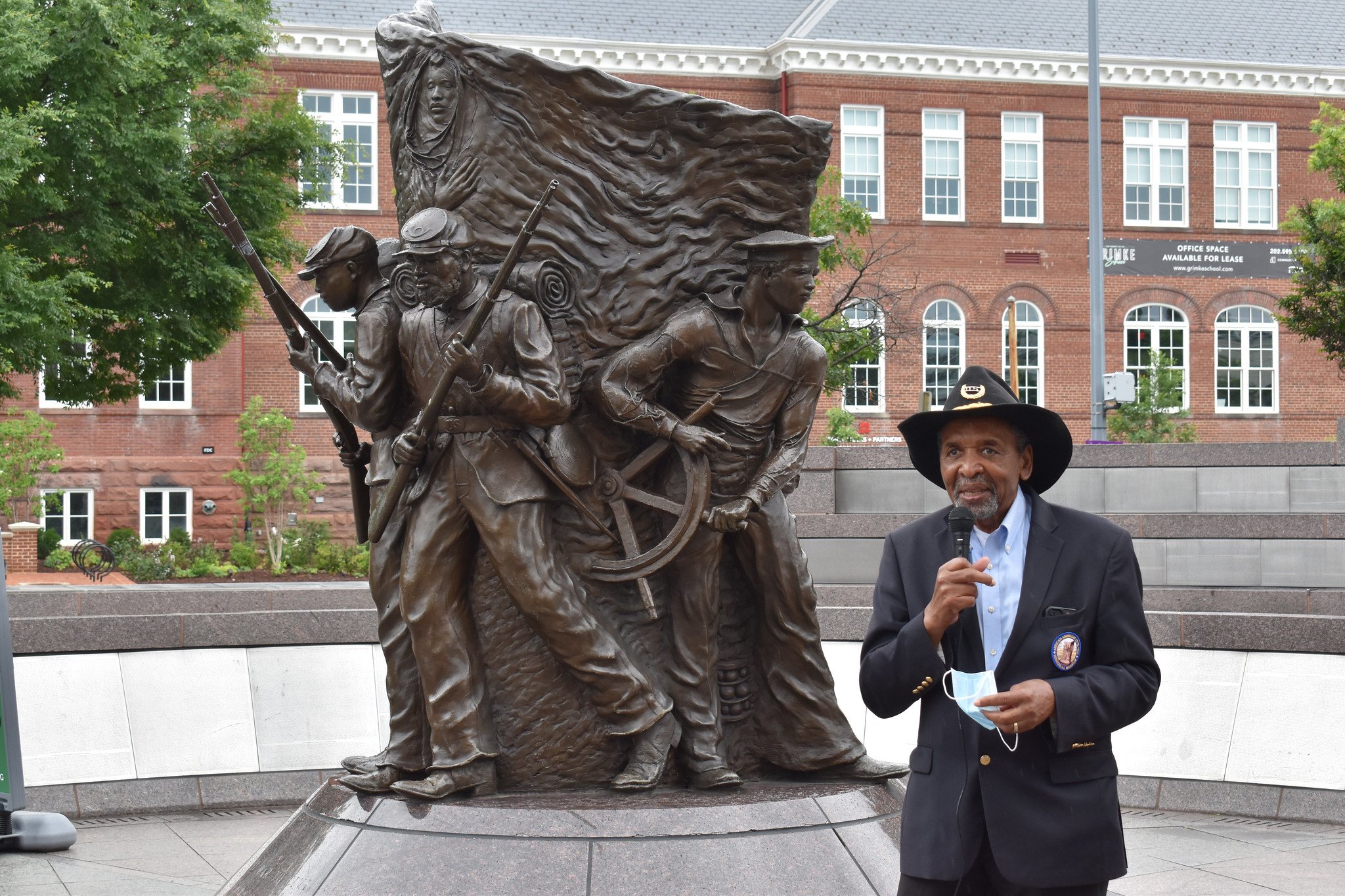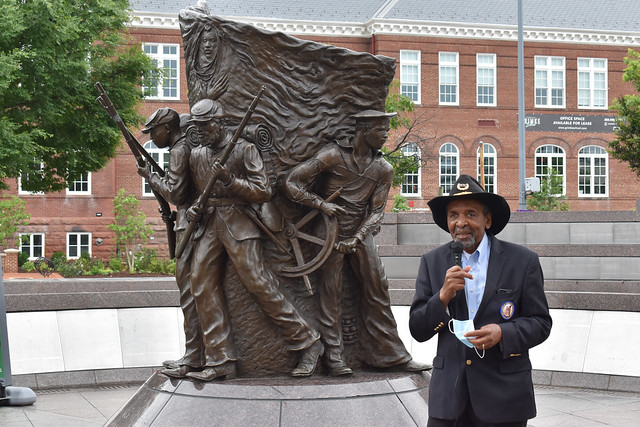Teach Truth Day of Action at AACWM 2022
“The Color Line…Teach it! Reconstructing the South…Teach it! Teaching SNCC…Teach it! What we don’t learn about the Prison Industrial Complex…Teach it! The Black Panther Party…Teach it! Who Gets to Vote? Teach it!”
Those were the chants heard at the African American Civil War Memorial in DC on Saturday, June 11 for the #TeachTruth event hosted nationally by the Zinn Education Project, African American Policy Forum, and Black Lives Matter at School.
Emcee Jessica Rucker led the call and response, starting off with Teach Truth syllabus lesson titles and encouraging crowd members to respond “Teach it!”
Dr. Frank Smith, the executive director of the African American Civil War Museum and SNCC veteran shared remarks, touching upon his time as a SNCC organizer:
Thank you very much. Welcome back to the African American Civil War Memorial Museum. And when we built this, we knew we were building a space for people who wanted to have a place where they could shout out whatever it was they wanted to shout about freedom and democracy around people who would recognize what they were saying.
Because on these walls are 209,000 names of African American soldiers who joined President Abraham Lincoln in the Civil War to fight for their freedom. They come in through paragraph eight of the Emancipation Proclamation. We call that the enforcement clause. Paragraph eight. The enforcement clause. Why do we call it the enforcement clause? Because Lincoln doesn't bring these guys into the army until he realizes he's losing and he cannot win the war without doing something about slavery.
He tried his best to win it without them. So when it comes to that point, he realizes he has to arm the slaves, because that's what the Emancipation Proclamation does. Of these 200,000 names on his walls out here, 150,000 of them were slaves when the war started.
And yes, I was a civil rights worker in Mississippi in the 1960s with a group called SNCC. I'm in Howard Zinn's book called The New Abolitionists. You can look me up. Frank Smith.
I was in Mississippi at the time. But the Civil Rights workers and I knew at a point that we were going to make a difference in the United States that something was going to happen. There were too many people involved. Black, white, Hispanic, young, old, gay, straight, too many of us.
But that feeling must have paled in the face of these guys that you see whose images you see on these walls and who Marquett represents here. Who, after all these years, 250 years of slavery, finally get a chance where they can walk out on the battlefield and do something about them, fight for their own freedom.
I can't imagine. For some of these guys, I'm sure they must have thought they died and went to heaven. Or they were asleep but having a good dream that they didn't want to wake up. You know how it is when you have a good dream, and somebody wakes you up, you just say, “Damn.”
I'm sure that's what they must have thought. At the end of the war, they passed the 13th Amendment which abolished slavery. You teach all of this. The 14th Amendment, which makes every African American a citizen. The 15th Amendment gives us the right to vote. And let me just say this because this is what Teach Truth means.
Without those three amendments, slavery doesn't end in the United States. Without those three amendments, you don't get women's right to vote. Without those three amendments, you don't get Roe v. Wade. Roe v. Wade is tied to the 14th Amendment. When they are debating the 14th Amendment and the Florida Congress, senators like Sumner and Stevens and others say these men earned their right to freedom on the battlefield. They earned their right to vote. This is how they get around giving women the right to vote, they discriminated, don't let women in the army. And then they say these guys can vote because they went to the army.
Well, there was half a loaf and it was better than nothing, especially for people who have been enslaved all this time. So when you say you have to teach the truth, we ought to teach the truth about what happened to this country. African Americans not only kept this country united under one flag, but we saved democracy.
Not only did we keep everyone united under one flag, but we saved democracy. Now the thanks we got was that we got Jim Crow at the end of that. And so we had to go to another civil war, which I was in, in the civil war with SNCC. And we may have to go to a third civil war if these people don't stop the stuff that they are doing now. And that's what your job is as teachers to teach these young people. Because I just met this young lady who's going to Howard University in the fall.
I went to Morehouse College in 1959. In 1960, I was arrested for the first time during a civil rights demonstration. By 1962, I was chairman of the movement. I came up from a plantation in Newnan, Georgia, with no running water and an outdoor toilet. The first person in my family to ever go to college. Nobody has ever been. So people ask me what do your parents think about you being in the Civil Rights movement? My parents had no idea what college students did. Nobody, nobody in my family ever went to college, they had no idea. They just knew I was gone. I was a good student. I went to a good college. And they had prayed for me and prayed me up and sent me out with the best they had. And they figured I'd be alright.
They were right about that. But they did tell me not to get myself into nothing I couldn't get myself out of. And that's where SNCC came in. That's right. We were a band of brothers and sisters. And a circle of trust. We trusted each other. We looked out for each other.
If one of us got put in jail, somebody would come to the jailhouse to see about us. We knew that. If they picked me up by myself on one of those lonely roads, before the nightfall, somebody from SNCC would be there. That's right. So there would be two of us in jail and then we started this program. If you put two of us in jail, two more are going to come. So now you got four. You put four of us in jail, four more are going to come. We come in multiples.
We come, there's a whole lot of us. And there ain't no jailhouse anywhere big enough to hold a whole bunch of people. Y'all know that, right. And when we filled up the jail, we turned the jails into freedom houses. We started singing freedom songs. Prisoners up in there started singing freedom songs. Serving 199 years and three bad days, they still singing about freedom, because they knew that what we were doing was going to change this country.
So I want to thank you all for coming today. Let me just say finally, we're moving into the building that you see right there, those two white steps are our new steps. We're moving our exhibit there in the fall. We have a new children's room in there. That's gonna be named for a woman who wrote a children's book about her Civil War ancestor. And so we're naming it. We've got permission to use images from the book for the room. And we're gonna feature that book as I mean, because we want to, and we're going to have a Fannie Lou Hamer hologram up in there. And Fannie Lou Hamer is gonna be singing freedom songs. We're gonna do karaoke. Marquett is going to teach them how to drill. He does something called schooling soldier, which is three of them. They drill to these freedom songs. With Fannie Lou Hamer singing, we shall overcome and we shall not be moved, and they don't let nobody turn me around. We got to train the next generation. We do what we can here, you do what you can in your classroom, and we'll keep this country going in the right direction. Thank you all very much.
Educators from across the D.C. area were also encouraged to come up to the microphone and explain why they chose to “Teach Truth.”
Nicole Clarke, a seventh grade history teacher at a D.C. charter school explained why she was pledging to #TeachTruth: “One of the goals of teaching history is so we don’t recreate the mistakes of the past. It's not to teach students that we have a history with no mistakes.” Scott Goldstein, currently working for Empower Ed but a former high school teacher at Roosevelt High School in D.C., stressed the importance of organizations like the Zinn Education Project: “DC is about to put out new social studies standards. And for those who haven't seen, we got to make sure that those Social Studies standards teach the truth, but also know even when they don't, there's gonna be plenty of people like you who are going to teach the truth anyway because you got the resources in place like Zinn Education Project and Teach the Truth. So I pledge as all of you continue to teach the truth, to have the backs of educators who are teaching the truth.”
Michelle Coles, author of the YA book Black Was the Ink, shared why one of her goals with writing her book and why she pledged to #TeachTruth:
One of the things that I hope to do, or my pledge, is to write stories that help people see the connection between the present and the past. And I think that's so important, is to not think the past is just behind us, behind a door, it's forgotten, and it doesn't have any continuing relevance to what we're living through today. And so what I try to do is write these stories so that people can see those continuing threads. And I hope that the stories leave young people in particular, feeling empowered, and also feeling full of pride. And with that, being able to realize and see that they have to be the change that they want to see in the world.
More Photos
Our thanks to May Kotsen, 2022 summer intern and rising senior at Connecticut College, for preparing this story.






